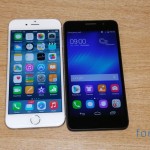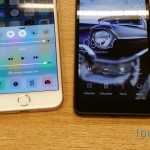 F0r any manufacturer hoping to release a successful slate-style handset, there are likely to be considerable comparisons with the latest handset from Apple who are arguably the most successful at launching candybar style handsets. Huawei’s latest handset for Europe may come with the Huawei branding but still aims to compete with the best from Apple so how does the Honor 6 stack up against the juggernaut that is Apple’s iPhone 6?
F0r any manufacturer hoping to release a successful slate-style handset, there are likely to be considerable comparisons with the latest handset from Apple who are arguably the most successful at launching candybar style handsets. Huawei’s latest handset for Europe may come with the Huawei branding but still aims to compete with the best from Apple so how does the Honor 6 stack up against the juggernaut that is Apple’s iPhone 6?  The Honor 6 might cost less than the iPhone 6 but it doesn’t mean it features reduced specs; in fact, the display is significantly better than the iPhone 6 and offers Full HD resolution on a panel measuring 5 inches compared to the 4.7 inch 750p HD panel on the iPhone 6. The Honor 6 uses IPS LCD technology compared to the Retina Display on the iPhone 6 and in real-world usage, the 326 pixels per inch density offered by the iPhone 6 pales to the Honor 6 which at 445 ppi is significantly more vibrant and immersive.
The Honor 6 might cost less than the iPhone 6 but it doesn’t mean it features reduced specs; in fact, the display is significantly better than the iPhone 6 and offers Full HD resolution on a panel measuring 5 inches compared to the 4.7 inch 750p HD panel on the iPhone 6. The Honor 6 uses IPS LCD technology compared to the Retina Display on the iPhone 6 and in real-world usage, the 326 pixels per inch density offered by the iPhone 6 pales to the Honor 6 which at 445 ppi is significantly more vibrant and immersive.  Under the hood the Honor 6 is powered by an octa-core Kirin 920 processor with 3GB RAM, 16GB/32GB storage with microSD card expansion and a Mali-T628 MP4 graphics chip. In comparison the iPhone 6 has a dual-core 1.4GHz Apple A8 processor with 1GB RAM and 16GB/64GB/128GB storage that’s non-expandable. Whilst on paper the Honor 6 has much better specs, Apple have the benefit of optimising their hardware and software and we saw little difference in performance between the two handsets (although the Honor 6 did appear to be much smoother when running resource intensive tasks).
Under the hood the Honor 6 is powered by an octa-core Kirin 920 processor with 3GB RAM, 16GB/32GB storage with microSD card expansion and a Mali-T628 MP4 graphics chip. In comparison the iPhone 6 has a dual-core 1.4GHz Apple A8 processor with 1GB RAM and 16GB/64GB/128GB storage that’s non-expandable. Whilst on paper the Honor 6 has much better specs, Apple have the benefit of optimising their hardware and software and we saw little difference in performance between the two handsets (although the Honor 6 did appear to be much smoother when running resource intensive tasks).  On the back the iPhone 6 has a 8MP iSight camera with 1.5µm pixel size and a dual LED true-tone flash. The increased pixel size allows more light to enter the sensor resulting in supposedly better images in low light conditions. In comparison, the Honor 6 sports a 13MP sensor with dual-LED flash and in our testing, we found the iPhone camera still remains one of the best with the Honor 6 performing well but not as well as the iPhone. On the front the iPhone 6 makes do with a 1.2MP front sensor whilst the Honor 6 brings Huawei’s selfie game and offers a 5MP snapper.
On the back the iPhone 6 has a 8MP iSight camera with 1.5µm pixel size and a dual LED true-tone flash. The increased pixel size allows more light to enter the sensor resulting in supposedly better images in low light conditions. In comparison, the Honor 6 sports a 13MP sensor with dual-LED flash and in our testing, we found the iPhone camera still remains one of the best with the Honor 6 performing well but not as well as the iPhone. On the front the iPhone 6 makes do with a 1.2MP front sensor whilst the Honor 6 brings Huawei’s selfie game and offers a 5MP snapper.  These two handsets also differ in the connectivity stakes with the Honor 6 demonstrating Huawei’s considerable knowledge of mobile networks. The iPhone 6 sports LTE Cat 4 (offering download speeds of 150Mbps) but the Honor 6 tops this as one of just a few handsets to sport LTE Cat 6 which offers download speeds of up to 300Mbps. Other connectivity options on both handsets include DC-HSDPA (42Mbps download), Wi-Fi n (with ac as well on the iPhone 6), Bluetooth v4.0 and integrated GPS. There’s also NFC onboard both handsets (limited to just Apple Pay on the iPhone 6) along with a plethora of sensors.
These two handsets also differ in the connectivity stakes with the Honor 6 demonstrating Huawei’s considerable knowledge of mobile networks. The iPhone 6 sports LTE Cat 4 (offering download speeds of 150Mbps) but the Honor 6 tops this as one of just a few handsets to sport LTE Cat 6 which offers download speeds of up to 300Mbps. Other connectivity options on both handsets include DC-HSDPA (42Mbps download), Wi-Fi n (with ac as well on the iPhone 6), Bluetooth v4.0 and integrated GPS. There’s also NFC onboard both handsets (limited to just Apple Pay on the iPhone 6) along with a plethora of sensors.  The key area where the two handsets should largely differ is the software and interface and whilst they do, there are certainly some similarities. The key thing you’ll notice is that the Honor 6 doesn’t sport an app drawer with Huawei instead preferring to adopt a style similar to Apple’s with all the apps residing on the homepage. On the Honor 6, swiping up from the bottom on the lock screen brings up a shortcut menu just like Control Centre on the iPhone 6, but unlike Apple’s handset this is limited to just the lock screen. Unlike iOS however, the Android OS on the Honor 6 allows Huawei to add widgets, customise on-screen navigation options and tweak all aspects of the user interface. Whilst we had hoped that Huawei would adopt a more stock-like approach for the Honor 6, the Emotion UI isn’t all bad and is definitely usable.
The key area where the two handsets should largely differ is the software and interface and whilst they do, there are certainly some similarities. The key thing you’ll notice is that the Honor 6 doesn’t sport an app drawer with Huawei instead preferring to adopt a style similar to Apple’s with all the apps residing on the homepage. On the Honor 6, swiping up from the bottom on the lock screen brings up a shortcut menu just like Control Centre on the iPhone 6, but unlike Apple’s handset this is limited to just the lock screen. Unlike iOS however, the Android OS on the Honor 6 allows Huawei to add widgets, customise on-screen navigation options and tweak all aspects of the user interface. Whilst we had hoped that Huawei would adopt a more stock-like approach for the Honor 6, the Emotion UI isn’t all bad and is definitely usable.
Overall these two handsets have many similarities but one major difference is in the price tag; the iPhone 6 retails from £539 SIM free whilst the Honor 6 4G smartphone can be had for just £249.99 SIM free direct from Amazon UK. The iPhone 6 costs more than two Honor 6 smartphones and with Android offering additional launchers available to download from Google Play, even if you’re not a fan of Emotion UI, you should definitely be looking at the Honor 6.













